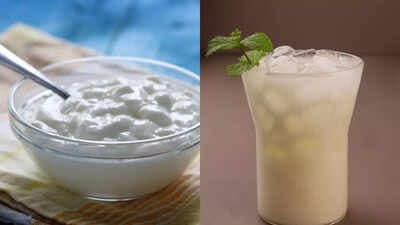When it comes to traditional dairy foods, few can match the refreshing taste and nutritional richness of curd and buttermilk. Both have held a cherished place in Indian diets for generations, known for their cooling effect, probiotic goodness, and digestive benefits.Despite their close connection, as buttermilk is derived from curd, these two dairy staples differ greatly in texture, composition, and health impact. Curd is thicker and richer, packed with calcium and protein, while buttermilk is lighter, hydrating, and ideal for digestion. Understanding the difference between curd and buttermilk helps you choose the right one to support your body’s needs, whether it’s for better digestion, hydration, or overall wellness.Comparing the health benefits of curd and buttermilkCurdCurd, or dahi, is a fermented dairy product made by adding a small amount of culture (lactic acid bacteria) to warm milk. This bacterium converts milk sugar (lactose) into lactic acid, which causes the milk to thicken and develop a mildly sour taste.Traditionally set at home, curd is a natural source of probiotics that support digestion and gut health. It’s thicker, creamier, and more filling than buttermilk, making it a versatile ingredient for both sweet and savoury dishes.ButtermilkButtermilk, or chaas, is the thin, refreshing liquid left behind after churning butter from cream or curd. In modern households, it’s often prepared by whisking curd with water, salt, and digestive spices such as cumin, ginger, and coriander leaves.Light, tangy, and easy to digest, buttermilk is often considered a natural digestive tonic and summer coolant. It helps restore hydration and supports gut function without the heaviness of milk or curd.Differentiating between curd and buttermilk: Key parameters explainedWhen it comes to choosing between curd and buttermilk for specific health goals, each offers unique advantages depending on your body’s needs. Both are rich in probiotics that promote a healthy gut and aid digestion, but their texture, composition, and nutrient balance determine how they support various aspects of health, from weight management to bone strength and hydration. According toa study published in the Journal of Dairy Science, regular consumption of fermented dairy products like curd and buttermilk can significantly improve gut microbiota balance and enhance digestive health.Here’s a closer look at how each fares across different health parameters.For digestionButtermilk is ideal for those who suffer from acidity or bloating. Its light consistency helps flush toxins, and the probiotic bacteria regulate digestion. Curd is also good for the gut but may feel heavy if consumed in excess, especially at night.For weight lossIf you’re watching calories, buttermilk is your best friend. It delivers the goodness of curd with fewer calories and fat, making it a smart replacement for sugary drinks or milk-based beverages.For bone healthCurd wins here. It’s packed with calcium and phosphorus, which help maintain bone density and strength, especially important for children, women, and the elderly.For hydration and coolingDuring hot weather, buttermilk outperforms curd. It replenishes fluids, prevents heat strokes, and keeps the digestive system light.For lactose intoleranceBoth are easier to digest than milk, but buttermilk has lower lactose content due to dilution, making it gentler for sensitive individuals.ParameterCurdButtermilkBase ingredientFermented milkLiquid leftover after churning curdConsistencyThick and creamyThin and wateryTasteMildly sourTangy and refreshingCalorie contentHigherLowerProbiotic concentrationHighModerateBest time to consumeWith meals or as part of lunchAfter meals or during hot daysIdeal forBone strength, gut healthDigestion, hydration, and acidity reliefStorage lifeShorter, best when freshLonger can be refrigeratedTraditional and culinary uses of curd and buttermilkCurd in cookingCurd is a staple in Indian and Mediterranean cuisines. It’s used in:Raita and dips for cooling spicy meals.Marinades for meats and paneer, adding tenderness and flavour.Desserts like shrikhand or sweet lassi.Curries such as kadhi or dahi chicken.Buttermilk in cookingButtermilk’s tangy taste and thin texture make it a versatile ingredient too. It’s used in:Kadhi, a popular Indian comfort dish.Baking (as in pancakes, scones, or muffins) for lightness and flavour.Drinks like masala chaas, a spiced digestive beverage.Fermented foods like dosa or idli batter enhance the rise and taste.Homemade is always betterStore-bought curd and buttermilk often contain preservatives or stabilisers that reduce probiotic value. To get the full benefits:Set curd at home using fresh milk and a spoonful of the previous-day curd as a starter.Prepare buttermilk by whisking curd with chilled water and adding a pinch of salt, cumin, or mint.Homemade versions are richer in live cultures, more digestible, and free from additives.Which one should you choose: Curd or buttermilkBoth curd and buttermilk are nutritious, probiotic-rich foods that support gut health, immunity, and hydration.Choose curd for stronger bones, better gut flora, and a nutrient boost.Choose buttermilk for lighter digestion, cooling relief, and hydration.For a balanced diet, include both curd with your lunch and buttermilk after your meals, to enjoy the best of both worlds.Disclaimer: This article is for informational purposes only and should not be considered medical advice. Please consult a healthcare professional before making any changes to your diet, medication, or lifestyle.Also read |Black chokeberry juice: Natural way to regulate blood sugar and maintain healthy blood pressure levels
Curd vs Buttermilk: Uncovering the Unique Health Benefits of Each
Times of India•

Full News
Share:
Disclaimer: This content has not been generated, created or edited by Achira News.
Publisher: Times of India
Want to join the conversation?
Download our mobile app to comment, share your thoughts, and interact with other readers.